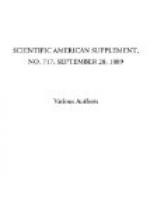* * * * *
THE ELECTRIC AGE.
By CHARLES CARLETON COFFIN.
The application of electricity for our convenience and comfort is one of the marvels of the age. Never in the history of the world has there been so rapid a development of an occult science. Prior to 1819 very little was known in regard to magnetism and electricity. During that year Oersted discovered that an electric current would deflect a magnetic needle, thus showing that there was some relationship between electric and magnetic force. A few months later, Arago and Sir Humphry Davy, independently of each other, discovered that by coiling a wire around a piece of iron, and passing an electric current through it, the iron would possess for the time being all the properties of a magnet. In 1825 William Sturgeon, of London, bent a piece of wire in the form of the letter U, wound a second wire around it, and, upon connecting it with a galvanic battery, discovered that the first wire became magnetic, but lost its magnetic property the moment the battery was disconnected. The idea of a telegraphic signal came to him, but the electric impulse, through his rude apparatus, faded out at a distance of fifty feet. In 1830 Prof. Joseph Henry, of this country, constructed a line of wire, one and a half miles in length, and sent a current of electricity through it, ringing a bell at the farther end. The following year Professor Faraday discovered magnetic induction. This, in brief, is the genesis of magnetic electricity, which is the basis of all that has been accomplished in electrical science.
The first advance after these discoveries was in the development of the electric telegraph—the discovery in 1837, by the philosopher Steinhill, that the earth could serve as a conductor, thus requiring but one wire in the employment of an electric current. Simultaneously came Morse’s invention of the mechanism for the telegraph in 1844, foreshadowed by Henry in the ringing of bells, thus transmitting intelligence by sound. Four years later, in 1848, Prof. M. G. Farmer, still living in Eliot, Me., attached an electro-magnet to clockwork for the striking of bells to give an alarm of fire. The same idea came to William F. Channing. The mechanism, constructed simply to illustrate the idea by Professor Farmer, was placed upon the roof of the Court House in Boston, and connected with the telegraph wire leading to New York, and an alarm rung by the operator in that city. The application of electricity for giving definite information to firemen was first made in Boston, and it was my privilege to give the first alarm on the afternoon of April 12, 1852.




